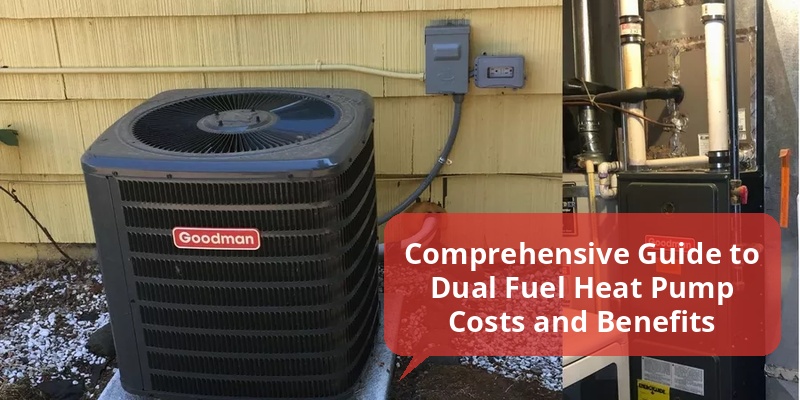Dual fuel heat pumps combine the efficiency of heat pumps with the reliability of a furnace, offering an effective heating solution for many American homes. Understanding the dual fuel heat pump cost involves more than just the initial price; it also includes installation, maintenance, and long-term energy savings. This article breaks down these costs and provides insight into whether a dual fuel system is the right choice for your household.
| Cost Factor | Price Range | Notes |
|---|---|---|
| Heat Pump Unit | $3,500 – $7,500 | Depends on capacity and brand |
| Furnace Unit | $2,500 – $6,000 | Gas or electric furnace included |
| Installation | $2,000 – $5,000 | Varies by region and complexity |
| Annual Maintenance | $150 – $300 | Essential for efficient operation |
| Energy Savings | Up to 30% reduction | Compared to traditional heating systems |
What Is a Dual Fuel Heat Pump?
A dual fuel heat pump system uses two energy sources to heat and cool a home efficiently. It typically pairs an electric heat pump with a gas furnace, switching between the two depending on outdoor temperatures. This setup optimizes energy use by running the heat pump during milder weather and the furnace during extreme cold.
This technology increases household comfort while maximizing energy savings, making it a popular choice in climates with diverse seasonal temperatures.
Factors Influencing Dual Fuel Heat Pump Cost
Several variables impact the overall cost of a dual fuel heat pump system. These include:
- System Capacity: Larger and more efficient units cost more but may save on energy bills over time.
- Brand and Model: Premium brands with advanced features have higher price tags.
- Installation Complexity: Costs vary if ductwork modifications or electrical upgrades are needed.
- Geographic Location: Labor rates and climate influence both purchase and operational costs.
- Fuel Type: The choice between natural gas or propane furnaces affects prices and running costs.
Initial Purchase Price Breakdown
| Component | Cost Range | Description |
|---|---|---|
| Heat Pump Unit | $3,500 – $7,500 | Capacity typically between 2 to 5 tons; higher SEER ratings increase price. |
| Gas Furnace | $2,500 – $6,000 | Includes high-efficiency models with AFUE ratings from 80% to 98%. |
| Thermostat and Controls | $200 – $600 | Smart thermostats optimize switching between heat pump and furnace. |
The combined cost for equipment usually ranges between $6,200 and $14,100 before installation.
Installation Costs and Considerations
Professional installation is critical for the optimal functionality of a dual fuel system. Installation costs typically range from $2,000 to $5,000. Factors affecting these costs include:
- Ductwork Adjustments: Older homes may require modifications or new duct systems.
- Electrical Upgrades: Heat pumps require appropriate electrical service to handle load.
- Site Preparation: Placement of outdoor units and furnace connections can add costs.
Licensed HVAC technicians often conduct site evaluations to provide precise estimates.
Operating Costs and Energy Efficiency
Dual fuel systems are designed to maximize operating efficiency by switching between energy sources. Heat pumps provide heating via electricity and cooling during summer, while the furnace backs up heating in extreme cold. This reduces reliance on expensive electric heating during winter peaks.
Operating cost advantages include:
- Lower electricity usage in moderate climates.
- Utilization of natural gas or propane when more cost-effective.
- Potential fuel cost savings of up to 30% compared to traditional electric resistance heating.
Energy-efficient models also qualify for federal and state incentives, helping offset operational expenses.
Maintenance Expenses for Dual Fuel Heat Pumps
Routine maintenance is essential to sustain energy efficiency and system longevity. Annual inspections typically cost between $150 and $300. Key maintenance tasks include:
- Cleaning or replacing air filters in the heat pump and furnace.
- Checking refrigerant levels and heat exchanger conditions.
- Inspecting ductwork for leaks and insulation quality.
- Calibrating thermostats and control systems.
Scheduling regular maintenance with a certified technician can prevent costly repairs and ensure optimized performance.
Financial Incentives and Rebates
Many American homeowners can take advantage of incentives that reduce the upfront cost of dual fuel heat pump systems. These incentives include:
- Federal Tax Credits: The Inflation Reduction Act offers credits for energy-efficient systems.
- State and Local Rebates: Programs vary widely but may cover part of installation or equipment costs.
- Utility Company Discounts: Some utility providers offer rebates or discounted rates for dual fuel users.
Researching these programs before purchasing is crucial to maximizing savings.
Is a Dual Fuel Heat Pump Worth the Investment?
Dual fuel heat pumps blend electric and gas technology to provide efficient heating and cooling year-round. While the initial investment is substantial, long-term energy savings and system reliability make them a compelling option in varied climates.
They deliver superior comfort, reduce energy bills during fluctuating temperatures, and have incentives that improve affordability. Homeowners facing high electric heating costs or living in regions with cold winters can particularly benefit from a dual fuel system.
